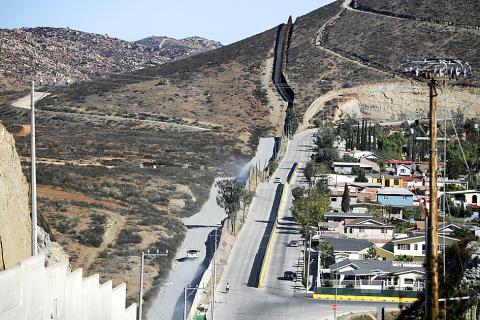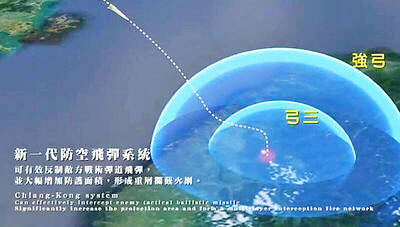The administration of US President Donald Trump has proposed spending US$18 billion over 10 years to significantly extend the border wall with Mexico, providing one of its most detailed blueprints of how Trump hopes to carry out a signature campaign pledge.
The proposal by US Customs and Border Protection calls for 505km of additional barrier by September 2027, bringing total coverage to 1,552km, or nearly half the border, a US official with direct knowledge of the matter said.
It also calls for 651km of replacement or secondary fencing, said the official, who spoke on the condition of anonymity because the plan has not been made public.

Photo: AP
Trump has promised “a big, beautiful wall” with Mexico as a centerpiece of his presidency, but offered few details of where it would be built, when and at what cost.
His administration asked for US$1.6 billion this year to build or replace 118km of fencing in Texas and California, and officials have said they also would seek US$1.6 billion next year.
The 10-year plan, first reported by the Wall Street Journal, resulted from discussions with US senators who asked the agency what it would take to secure the border, the official said.
It comes as the US administration intensifies negotiations in the US Congress on a package that might include granting legal status to about 800,000 people who were temporarily shielded from deportation under Deferred Action for Childhood Arrivals (DACA), a program enacted by the administration of former US president Barack Obama.
Trump last year said that he was ending DACA, but gave Congress until March to deliver a legislative fix.
The plan on border security came in response to a request by US Senator Jeff Flake, his spokesman Jason Samuels said.
A US administration official confirmed that the document was prepared at the request of congressional negotiators and said that funding for the wall and other security measures must be part of any legislative package on immigration.
US Secretary of Homeland Security Kirstjen Nielsen on Tuesday said that the wall would be “first and foremost” in any package that includes new protections for DACA recipients.
The US administration wanted to close “loopholes” on issues that include handling asylum claims and local police working with immigration authorities, she added.
Nielsen called the US$3.2 billion requests for fencing during the Trump administration’s first two years a “down payment.”
“This is not going to get us the whole wall we need, but it’s a start,” she said.
Mexico has steadfastly rejected Trump’s demand that it pay for the wall and few doubt that US taxpayers would foot the bill if the wall is built.
The US border agency document calls for a total of US$33 billion in new border spending, including US$18 billion for the wall, US$5.7 billion for technology gear, US$1 billion for road construction and maintenance, and US$8.5 billion for 5,000 new border patrol agents, 2,500 border inspectors and other personnel, the official said.
The document does not specify where the extended wall should be built.

LIMITS: While China increases military pressure on Taiwan and expands its use of cognitive warfare, it is unwilling to target tech supply chains, the report said US and Taiwan military officials have warned that the Chinese People’s Liberation Army (PLA) could implement a blockade within “a matter of hours” and need only “minimal conversion time” prior to an attack on Taiwan, a report released on Tuesday by the US Senate’s China Economic and Security Review Commission said. “While there is no indication that China is planning an imminent attack, the United States and its allies and partners can no longer assume that a Taiwan contingency is a distant possibility for which they would have ample time to prepare,” it said. The commission made the comments in its annual

DETERMINATION: Beijing’s actions toward Tokyo have drawn international attention, but would likely bolster regional coordination and defense networks, the report said Japanese Prime Minister Sanae Takaichi’s administration is likely to prioritize security reforms and deterrence in the face of recent “hybrid” threats from China, the National Security Bureau (NSB) said. The bureau made the assessment in a written report to the Legislative Yuan ahead of an oral report and questions-and-answers session at the legislature’s Foreign Affairs and National Defense Committee tomorrow. The key points of Japan’s security reforms would be to reinforce security cooperation with the US, including enhancing defense deployment in the first island chain, pushing forward the integrated command and operations of the Japan Self-Defense Forces and US Forces Japan, as

‘TROUBLEMAKER’: Most countries believe that it is China — rather than Taiwan — that is undermining regional peace and stability with its coercive tactics, the president said China should restrain itself and refrain from being a troublemaker that sabotages peace and stability in the Indo-Pacific region, President William Lai (賴清德) said yesterday. Lai made the remarks after China Coast Guard vessels sailed into disputed waters off the Senkaku Islands — known as the Diaoyutai Islands (釣魚台) in Taiwan — following a remark Japanese Prime Minister Sanae Takaichi made regarding Taiwan. Takaichi during a parliamentary session on Nov. 7 said that a “Taiwan contingency” involving a Chinese naval blockade could qualify as a “survival-threatening situation” for Japan, and trigger Tokyo’s deployment of its military for defense. Asked about the escalating tensions

INTERCEPTION: The 30km test ceiling shows that the CSIST is capable of producing missiles that could stop inbound missiles as they re-enter the atmosphere Recent missile tests by the Chungshan Institute of Science and Technology (CSIST) show that Taiwan’s missiles are capable of intercepting ballistic missiles as they re-enter the atmosphere and pose a significant deterrent to Chinese missile threats, former Hsiung Feng III missile development project chief engineer Chang Cheng (張誠) said yesterday. The military-affiliated institute has been conducting missile tests, believed to be related to Project Chiang Kung (強弓) at Pingtung County’s Jiupeng Military Base, with many tests deviating from past practices of setting restriction zones at “unlimited” and instead clearly stating a 30.48km range, Chang said. “Unlimited” restrictions zones for missile tests is